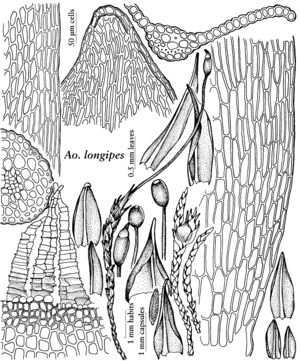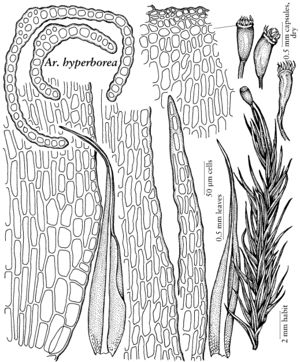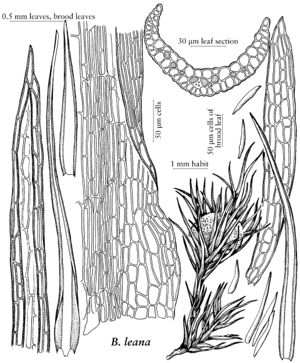Dicranaceae
Plants small to large, often in dense tufts. Stems erect, simple or dichotomously to irregularly branched, usually with central strand, often densely radiculose, tips occasionally deciduous. Leaves in several rows around the stem, erect or secund, often falcate-secund, sometimes crispate, short- to long-lanceolate, whole leaves or their tips sometimes deciduous; costa single, usually strong, percurrent to excurrent, sometimes ending in a short to long hyaline awn, smooth, ridged or lamellose on abaxial surface, rhizoids occasionally on adaxial or abaxial surface near leaf base; laminal cells smooth or sometimes distal cells mammillose or papillose on one or both sides, papillae rarely forked, or toothed by projecting cell ends, pitted or nonpitted; proximal cells elongate, often differentiated in alar region, sometimes undifferentiated. Specialized asexual reproduction absent or occasionally present as brood leaves, microphyllous branches, borne in axils of distal leaves or as rhizoidal tubers. Sexual condition autoicous, dioicous or pseudomonoicous. Seta solitary or several per perichaetium, elongate, usually straight, sometimes flexuose or cygneous. Capsule exserted, erect, inclined, or sometimes curved, cylindrical or ovoid, smooth, ridged, furrowed or irregularly wrinkled, sometimes strumose; stomata present or absent, superficial; annulus present or absent, often compound, deciduous or persistent; operculum conic or obliquely rostrate from a conic base; peristome single, usually of 16 lanceolate teeth, deeply divided into 2 or rarely 3 divisions, usually vertically striolate or pitted-striolate proximally, papillose distally. Calyptra cucullate, smooth, naked, sometimes fringed at base, usually covering most of capsule, fugacious. Spores mostly spheric, smooth to papillose.
Distribution
Worldwide.
Discussion
Genera 50–52, species ca. 900 (17 genera, 90 species in the flora).
Distinctive characters of this large acrocarpous family include the erect, often tomentose stems; mostly narrow, lanceolate, occasionally falcate or falcate-secund leaves, with a single, narrow to broad costa, with or without rhizoids at the base, sometimes ending in a hyaline, occasionally toothed apex, costa in cross section with or without stereid bands, leaf cells usually smooth, sometimes mammillose, or rarely with a single papilla on one or both sides, papillae rarely forked, asexual propagation by specialized deciduous branches, deciduous leaves or leaf apices, rarely rhizoidal tubers; sporophytes usually solitary or rarely clustered, setae mostly elongate, straight or rarely flexuose or cygneous, capsule cylindric to ovoid, erect to horizontal, smooth or ribbed, sometimes strumose, operculum usually obliquely rostrate, peristome single, with 16 teeth often divided 1/2 way to the base, usually striolate or pitted-striolate proximally, papillose distally.
Selected References
Lower Taxa
Illustrations
| Family ⠉ | Taxon | Illustrator ⠉ | |
|---|---|---|---|
 | Dicranaceae | Aongstroemia longipes | Patricia M. Eckel |
 | Dicranaceae | Arctoa hyperborea | Patricia M. Eckel |
 | Dicranaceae | Brothera leana | Patricia M. Eckel |
| ... further results | |||
Key
| 1 | Costa broad, occupying 1/3 or more of leaf base | > 2 |
| 1 | Costa narrow, occupying less than 1/3 of leaf base | > 6 |
| 2 | Costa in cross section with a median row of chlorocysts enclosed on both surfaces by a single row of hyalocysts, this sometimes interspersed with chlorocysts on abaxial surface | > 3 |
| 2 | Costa in cross section with a row of guide cells and stereid bands of cells | > 4 |
| 3 | Hyalocysts never interspersed with chlorocysts; plants yellowish or greenish; clusters of linear, twisted brood leaves in axils of upper leaves. | Brothera |
| 3 | Hyalocysts sometimes interspersed with chlorocysts on abaxial costa surface; plants often whitish green, sometimes yellowish green; clusters of brood leaves absent. | Paraleucobryum |
| 4 | Costa often without stereid cells above the guide cells; leaves acute or with a hyaline awn, the apex entire to serrate. | Campylopus |
| 4 | Costa always with stereid cells above and below the guide cells, smooth or nearly so; leaves narrowed to a long-setaceous, often serrulate apex | > 5 |
| 5 | Leaves not deciduous; rhizoids absent on abaxial surface of costa. | Campylopodiella |
| 5 | Leaves often deciduous; rhizoids often on abaxial surface of costa. | Dicranodontium |
| 6 | Plants slender and julaceous. | Aongstroemia |
| 6 | Plants not julaceous, leaves usually crisped, contorted, flexuose, spreading or falcate- secund | > 7 |
| 7 | Alar cells differentiated, inflated, hyaline or sometimes brown, often 2-stratose. | Dicranum |
| 7 | Alar cells not differentiated, or if so, then 1-stratose | > 8 |
| 8 | Leaves flexuose, falcate-secund or only rarely somewhat crisped when dry | > 9 |
| 8 | Leaves crisped and contorted when dry | > 11 |
| 9 | Costa in cross section with stereid bands. | Dicranella |
| 9 | Costa in cross section without stereid bands | > 10 |
| 10 | Capsule erect and symmetric; seta short, 3-6 mm. | Arctoa |
| 10 | Capsule suberect to inclined; seta long, 7-16 mm. | Kiaeria |
| 11 | Capsule distinctly to indistinctly ribbed when dry, often strumose | > 12 |
| 11 | Capsule smooth or wrinkled when dry, sometimes strumose | > 15 |
| 12 | Seta cygneous; capsule not strumose. | Oreas |
| 12 | Seta straight; capsule with or without a struma | > 13 |
| 13 | Leaves with laminae 1-stratose, cells smooth; capsules erect, without struma, often contracted below mouth when dry. | Rhabdoweisia |
| 13 | Leaves with distal cells of laminae often 2-stratose on margins or elsewhere, papillose or smooth; capsules inclined, often strumose, sometimes contracted below mouth when dry | > 14 |
| 14 | Leaf laminae often 2-stratose but only on margins, rarely elsewhere, cells smooth or papillose on adaxial and abaxial surfaces; capsule with or without struma, not contracted below mouth, striate when dry. | Cynodontium |
| 14 | Leaf laminae usually 1-stratose on margins but with 2-stratose regions elsewhere, cells strongly papillose, often with forked papillae; capsule always strumose, contracted below mouth and wrinkled when dry. | Dichodontium |
| 15 | Leaf cells with a large papilla on both adaxial and abaxial surfaces; capsules smooth. | Dichodontium |
| 15 | Leaf cells smooth or with longitudinal cuticular thickenings; capsules smooth or wrinkled | > 16 |
| 16 | Plants usually small, 1-2 cm; leaves with lanceolate base; capsule not strumose. | Dicranoweisia |
| 16 | Plants large, usually 2-5 cm; leaves with ovate or obovate base, often sheathing; capsule sometimes strumose | > 17 |
| 17 | Sporophytes single; capsule strumose. | Oncophorus |
| 17 | Sporophytes clustered; capsule not strumose. | Symblepharis |